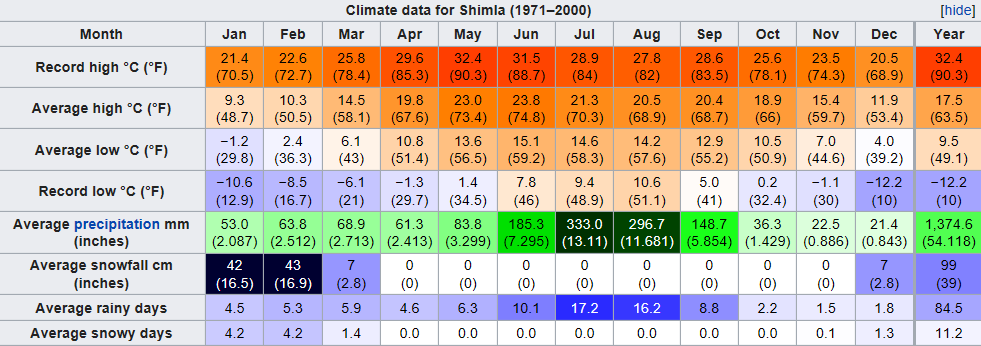Climate battle royale: Indian edition
Mar 30, 2018 23:13:37 GMT -5
Donar, alex992, and 3 more like this
Post by chesternz on Mar 30, 2018 23:13:37 GMT -5
India is rich in climatic diversity. I've picked out a baker's dozen for you to illustrate the broad range of climates in the subcontinent. Note that most of these are at elevation as this is primarily what enables such diversity (the highest climate is at 3500 m). I've ordered these in approximate descending order of warmth, so you can easily find the right Indian climate for you by looking at either the beginning or end of the list.

Nellore - Hottest place in India and one of the hottest in the world. Has a relatively brief monsoon. Sunshine hours probably similar to nearby Chennai (2800 hrs).

Panaji - Classic tropical savanna climate. Kinda similar to Darwin, Australia. It illustrates how abruptly the monsoon rains come - it's like flicking a switch. Impressive sunshine to rain ratio as the rain is heavily concentrated in a few months.

Ahmedabad - Typical Indian desert climate. July and August provide a taste of the tropics but the rest of the year is standard fare semi-arid.

Lonavla - If Panaji was too hot for your tastes perhaps some latitude and elevation would help? That's Lonavla in a nutshell - cooler and wetter than Panaji but similar seasonal patterns.

Bangalore - At nearly 1000 m elevation in the deep tropical South of India, Bangalore has a moderately hot climate year-round. Probably my favourite climate in India although the rain to sunshine ratio is relatively poor.

Mount Abu - This highland desert climate provides a much cooler and wetter experience than the lowlands and most people would probably find it fairly comfortable year-round (only one month with a high over 30 C). Sunshine probably ~2500 hrs.

Munnar - Warm but not hot. A good climate for hiking and taking in spectacular views of emerald green tea plantations. One of my favourites. Rainfall is a bit high though - especially in June Note that there still aren't that many rain days. But when it rains from June to August it rains very heavily, making the winding, mountainous roads particularly hazardous.
Note that there still aren't that many rain days. But when it rains from June to August it rains very heavily, making the winding, mountainous roads particularly hazardous.

Cherrapunji - Arguably the wettest place on earth (the title is disputed by a nearby village). Temperatures are moderate but with that rainfall (nearly twelve metres per year!) it will feel like you're taking a cold shower every time you go outside. But the dry season from Nov - Feb provides some relief.

Ooty - A cool suptropical highland climate with moderate rainfall year-round. About 2300 sunshine hrs.

Srinagar - Just about the closest thing to a classic four-season climate. Note that the sunniest period of the year is summer, in contrast to most of India. Winter would certainly have a very bleak feel to it whereas summers are reliably warm and sunny, enhancing the seasonal contrast further. Light to moderate rain year-round, but seemingly a lot of cloud to show for it.

Shimla - If you liked Srinagar but thought its summers were too warm and dry for you then this climate will be right up your alley. Averages over ten snow days per year, but moderate temps overall.

Leh - Leh (pronounced "lay") is an alpine desert at 3500 m elevation. Winters are properly cold, summers are moderately warm and it's bone dry year-round with barely 100 mm of annual rainfall. The barren landscape here looks like something from another planet.

Gulmarg - If you liked Leh but thought it was a little dry then maybe this'll be the ticket. Unsure of snow numbers but it looks like there's some serious potential (it's a skiing destination, after all).

Nellore - Hottest place in India and one of the hottest in the world. Has a relatively brief monsoon. Sunshine hours probably similar to nearby Chennai (2800 hrs).

Panaji - Classic tropical savanna climate. Kinda similar to Darwin, Australia. It illustrates how abruptly the monsoon rains come - it's like flicking a switch. Impressive sunshine to rain ratio as the rain is heavily concentrated in a few months.

Ahmedabad - Typical Indian desert climate. July and August provide a taste of the tropics but the rest of the year is standard fare semi-arid.

Lonavla - If Panaji was too hot for your tastes perhaps some latitude and elevation would help? That's Lonavla in a nutshell - cooler and wetter than Panaji but similar seasonal patterns.

Bangalore - At nearly 1000 m elevation in the deep tropical South of India, Bangalore has a moderately hot climate year-round. Probably my favourite climate in India although the rain to sunshine ratio is relatively poor.

Mount Abu - This highland desert climate provides a much cooler and wetter experience than the lowlands and most people would probably find it fairly comfortable year-round (only one month with a high over 30 C). Sunshine probably ~2500 hrs.

Munnar - Warm but not hot. A good climate for hiking and taking in spectacular views of emerald green tea plantations. One of my favourites. Rainfall is a bit high though - especially in June
 Note that there still aren't that many rain days. But when it rains from June to August it rains very heavily, making the winding, mountainous roads particularly hazardous.
Note that there still aren't that many rain days. But when it rains from June to August it rains very heavily, making the winding, mountainous roads particularly hazardous. 
Cherrapunji - Arguably the wettest place on earth (the title is disputed by a nearby village). Temperatures are moderate but with that rainfall (nearly twelve metres per year!) it will feel like you're taking a cold shower every time you go outside. But the dry season from Nov - Feb provides some relief.

Ooty - A cool suptropical highland climate with moderate rainfall year-round. About 2300 sunshine hrs.

Srinagar - Just about the closest thing to a classic four-season climate. Note that the sunniest period of the year is summer, in contrast to most of India. Winter would certainly have a very bleak feel to it whereas summers are reliably warm and sunny, enhancing the seasonal contrast further. Light to moderate rain year-round, but seemingly a lot of cloud to show for it.

Shimla - If you liked Srinagar but thought its summers were too warm and dry for you then this climate will be right up your alley. Averages over ten snow days per year, but moderate temps overall.

Leh - Leh (pronounced "lay") is an alpine desert at 3500 m elevation. Winters are properly cold, summers are moderately warm and it's bone dry year-round with barely 100 mm of annual rainfall. The barren landscape here looks like something from another planet.

Gulmarg - If you liked Leh but thought it was a little dry then maybe this'll be the ticket. Unsure of snow numbers but it looks like there's some serious potential (it's a skiing destination, after all).


 Lived:
Lived:

 Residence:
Residence:




